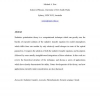Free Online Productivity Tools
i2Speak
i2Symbol
i2OCR
iTex2Img
iWeb2Print
iWeb2Shot
i2Type
iPdf2Split
iPdf2Merge
i2Bopomofo
i2Arabic
i2Style
i2Image
i2PDF
iLatex2Rtf
Sci2ools
93
Voted
ENVSOFT
2002
2002
Radiative perturbation theory: a review
Radiative perturbation theory is a computational technique which can greatly ease the burden of repeated solution of the radiative transfer equation for model atmospheres which differ from one another by only relatively small changes in some of the optical parameters. It requires the solution of both the radiative transfer equation, and its adjoint, followed by some usually straightforward integrations of these solutions. In this work we review the theoretical structure of the technique, and discuss a series of applications which have already demonstrated its utility. Future developments of the theory, and new applications currently under consideration, are also discussed.
| Added | 18 Dec 2010 |
| Updated | 18 Dec 2010 |
| Type | Journal |
| Year | 2002 |
| Where | ENVSOFT |
| Authors | Michael A. Box |
Comments (0)

